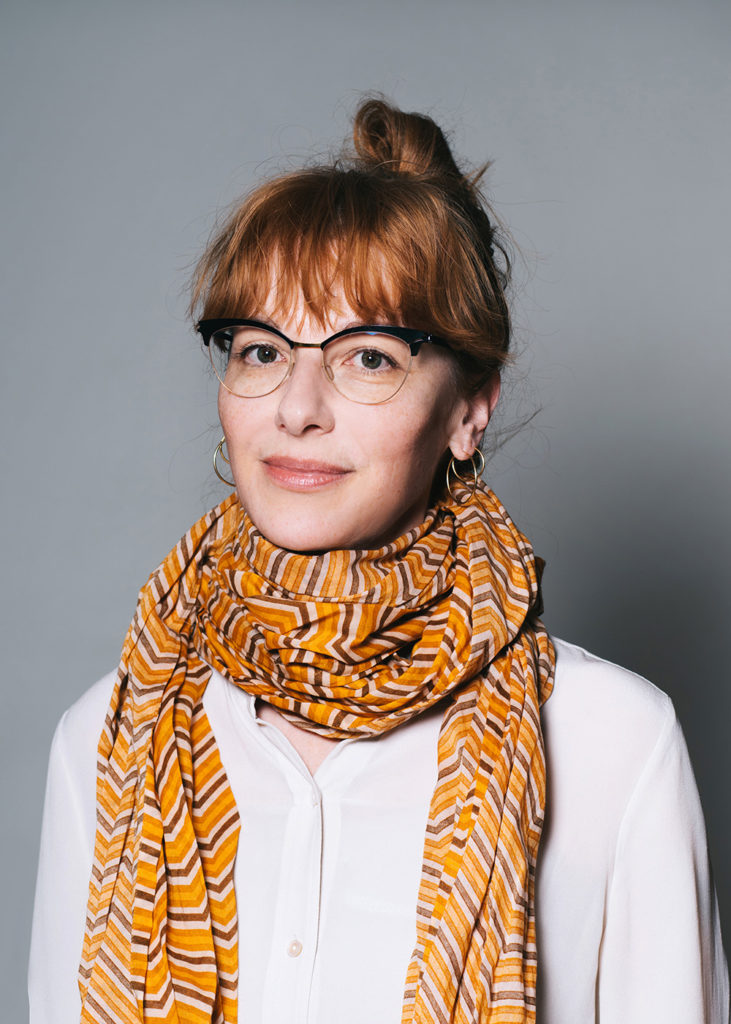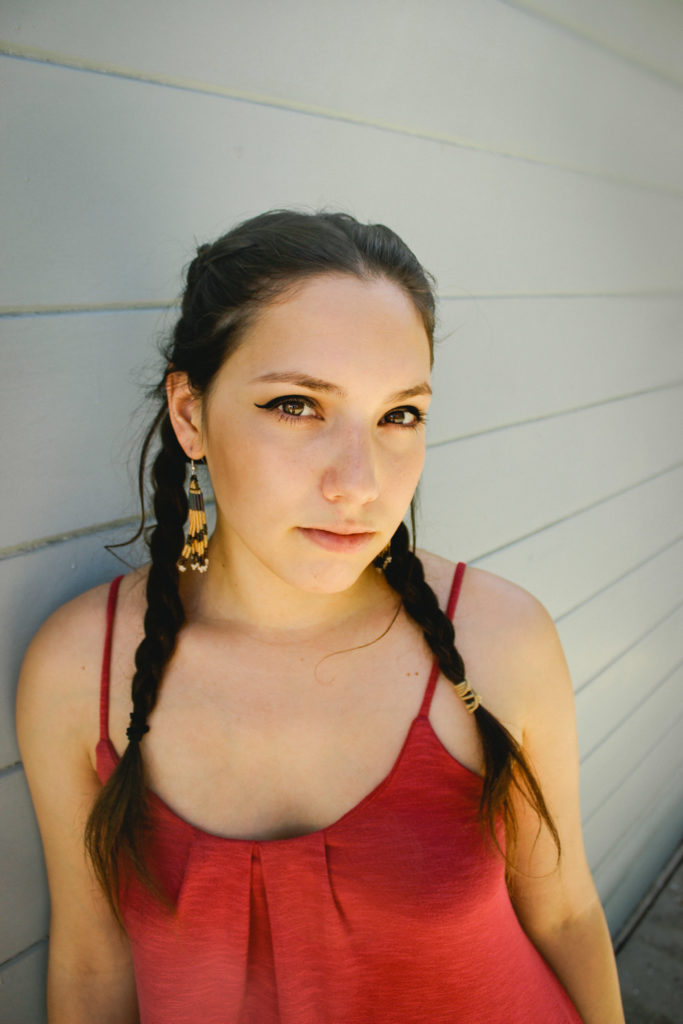Althea Thauberger and Suzanne Kite’s project Call to Arms was commissioned by the Toronto Biennial of Art (2019) and presented in partnership with HMCS York. On view until Dec. 2, the installation features audio and video recordings of rehearsals for a performance during the TBA’s opening weekend. Partners in Art helped fund the commission. Thauberger is speaking to PIA members on Nov. 28.
Canadian artist and filmmaker Althea Thauberger works with performative and collaborative processes both locally and internationally.
Oglala Lakota artist Kite, is a performance artist, visual artist, and composer.
Althea Thauberger
How did your career in art begin?
I had my first show when I was an undergrad student at Concordia in 1999 or 2000. It was a photo show in the Belgo building with my friends Marisa Portolese and Eve K. Tremblay. I still remember how excited we were.

What was your first successful solo art project?
I’m not sure if I have ever really had a successful solo project because my work has almost always been dependent on relationships with other artists, performers, and writers. The first time I felt that a work was successful on my terms was in a committee meeting during my MFA discussing this short film that I made called not afraid to die. My supervisors were kind of disoriented about how to talk about it. It had to do with it not lending itself to typical contemporary art critical terms of reference. I felt a power in that. For me, now the success of a project has to do straddling different worlds and registers. Often, I work creatively with people who do not care about contemporary art. If a project can be challenging and moving and meaningful in a particular community context, and also be the same in an art context, perhaps for different reasons, then it is successful on my terms.
What do you attribute to your strong performative and collaborative component of your practice?
I love the immediacy and physicality of performance work. In fact I wanted to be a singer and musician myself but thankfully I realized the limitation of my talent early on, and that it was just not going to work out! But in my current projects, I am right there in rehearsals and workshops. My skills lie more in facilitation, working with context. The collaborative part is about relationships and enactment. It is a question of how I want to live. My work is my life, and the relationships developed through projects are the relationships in my life, and a continual process of learning – which is such a privilege. Enactment is about the expression of politics. Because working with others and in relation to place is always political.
What do you consider your greatest achievement?
At this moment, I would say it is in the achievements of my current and former students—knowing I have been able to contribute, in some way, to developments in their work.
Is there a common thread throughout your work?
From my earliest works in art school until now, I have been interested in troubling forms of representation, most especially social documentary. Troubling, but still engaging with it. When I was a student, it was through photography, and of course since its beginnings, photography has had a, sometimes progressive, sometimes brutal history in social documentary. When a self-conscious politics and a space for poetry is part of that process, representation can be transcended into something more like emergence. This has been my concern since I started making work.
What do you do if you need inspiration?
If I feel stuck, it is often because there is a lack of clarity. Then I go back to basic questions, especially: Where am I? How am I where I am?
Which artists do you admire most?
The artists I most admire are people I have worked closely with, because then you get to appreciate someone’s process in a deeper way. Marianne Nicolson is one of those. Her work is situated in her ancestral community in the Dzawada’enuxw First Nation as a researcher and knowledge keeper, but it also translates out widely to international contexts, but always with that local advocacy at its centre. My dear friend Kerry Tribe is an artist and video maker based in L.A., and we have been following each other and also helping each other for more than 15 years now. Her work brings a conceptual materialist approach to media together with compassion and care for her subjects. I admire deeply Skeena Reece for her sheer brilliance and fearlessness as a performance artist and her ability to keep going, doing the tough work. And, Suzanne Kite, of course! Besides working on this project, I saw her perform recently in Vancouver. There is an incredible kind of temporal play and electricity in her work.
Is there an artist you like that would surprise people?
Nasreen Mohamedi. I’m not sure if that is surprising. I am really moved by her work.
Who would you want to create your portrait?
It has already happened! The right awesome Yuula Benivolski took my photo in her studio in Toronto this fall.
Suzanne Kite

When did you begin your musical career?
My involvement with music began at age five when I saw my aunt, Alicia Svigals, perform with the Klezmatics. The second time I saw her perform she gave me her first violin. I played violin intensely until college when I decided I was tired of playing music by dead men, and I should write my own.
As a composer and musician, what factors contributed to you working in visual and performative art platforms?
During my BFA at CalArts, there was a general sense that one could push the boundaries of musical performance, but mostly into audiovisual performance, sound installation, and experimental scores. It wasn’t until engaging with the community at Bard MFA was I able to see myself as an “Artist” or fully understand my composition practice as composing more than just sound and that perhaps sound was not at all necessary for a composition practice. I had already begun to understand my interface-development practice as listening with the body in connection with the computer, but soon arrived at understanding listening as something that opened possibilities to listen beyond a physical realm altogether.
What was your first successful solo art project?
I’m not sure what the metric of “success” is, but I think my BFA thesis work, which involved the collaborative efforts of many people, was my first personal successful solo artwork, a major win. The work is titled Omega, and was an experiment in finding seven methods of sonically counting to infinity. I had recently left the band I was in for years, experienced some severe health issues, multiple simultaneous traumas, including the cruelty of other people, making going to school nearly impossible, and retraumatizing daily. Finishing my first massive artwork with intellectual concepts I can stand behind years later, and staging it beautifully, proved to myself that this was the work I was cut out to do. If I could make that happen during that time, I can show up with good ideas and a good heart to any project. Like most of my successes, it would not have been possible without my partner and collaborator, Devin Ronneberg, or my longtime collaborator, James Hurwitz, who were my lifelines during that time.
What do you consider your greatest achievement?
My greatest achievement is staying alive. It often feels miraculous, as the Lakota women in my family have experienced generations of struggle; so many have not made it.
Is there a common thread throughout your work?
The throughlines in my work have been sonification, truth and belief, and Lakota ontology and epistemology. These throughlines are all related to each other and have led me to my academic work of my PhD and work with Indigenous protocols and artificial intelligence.
What do you do if you need inspiration?
I have often felt inundated with inspiration, more like a firehose that is difficult to turn off. If I need to develop a thought, I often just need a little quiet time and a hard deadline. A little artist’s block might do me some good.
Which artists do you admire most?
Well, after this project I really admire Althea’s ability to work with other people, I have learned a great deal from this project. I admire the work of other Indigenous artists who are concerned with listening: Nathan Young, Nadia Botello, Scott Benesiinaabandan, Raven Chacon and the (insane) minds of New Red Order (Adam Khalil, Zack Khalil, and Jackson Polys). The co-owner of my record label (Unheard Records), Mint Park, is a genius who needs to be brought to North America more often. But, I think all my friends are geniuses.
Is there an artist or musician you like that would surprise people?
Not surprising to my rave friends, but Drum n Bass and Jungle are still my #1 and I try to fit in references to the sonic world of the underground, even if I never go out anymore!
Who would you want to compose a piece of music just for you?
Well, since Raven Chacon already wrote me a piece in his work For Zitkala Sa, I will say I wish for S.P.Y to score a live performance…with full orchestra backing.
Kite and Thauberger
When and how did you learn about each other?
AT & SK: Candice Hopkins!
What was the highlight of working on this project together?
SK: The highlight of this project for me is a tie between hearing the Shell Ensemble play the work for the first time and eating nachos and drinking champagne with Althea and the sound crew (Travis Mercredi and Devin) on my birthday.
AT: Absolute same. I will forever remember the moment of hearing it for the first time, on that first rehearsal day. I was just blown away. In my memory it was actually the same night that we celebrated Suzanne’s birthday around a tiny table where we were staying in Toronto.
What were the challenges of working on this project?
AT: For me one of the challenges was that the time Suzanne and I, as well as the band, got to spend together was relatively short. Individually, Suzanne and I put a lot of consideration into the political and relational contexts of the project, but we had to meet in person to make key decisions, and for this, it was a matter of minutes and hours rather than days or weeks, which has been the case for me in recent projects. So, we had these two very intense, in-person meetings, one in the Vancouver airport, and the other in Devin Ronnenberg’s dining room in L.A. Actually, the time constraints were effective, and we quickly established these kind of overlapping conceptual wave lengths. I was surprised, in a way, of how much we did not have to spell out to each other, but just got to the work.
Describe your experience of having the HMCS York perform during the opening?
SK: Nerve-wracking, even though we had already recorded it. I rarely am in the audience for my artworks and not being able to experience walking the spiral with them was torture.
AT: I’m used to being in the audience, or being on the side of performance. I was a bit nervous at first, but I really got to enjoy it. I found it different from the rehearsals because of all the bodies in the room—different bodies from the military members to different audience members, and of course the shells and the architecture. The experience had a spiritual dimension. Including the last part of Suzanne’s score, when we all ate sheet cake together!
